Rare Earth Elements by Hull Corporation Japan
Hull Corporation manufactures a comprehensive catalog of rare earth materials, including high purity and ultra high purity metals, oxides, compounds, and organometallics in forms such as powders, nanopowders, solutions, and sputtering targets. We can custom manufacture all materials to customer specifications for shape, size, purity, composition in all amounts including bulk quantities. Above is a select list of AE Rare Earths products; you may also request a quote directly for any material we produce.
Rare Earth Elements
Cerium is the most abundant of the rare earths. It is characterized chemically by having two valence states , the +3 cerous and +4 ceric states. The ceric state is the only non-trivalent rare earth ion stable in aqueous solutions, making it strongly acidic and moderately toxic, as well as a strong oxidizer.The cerous state closely resembles the other trivalent rare earths. The numerous commercial applications for cerium include metallurgy, glass and glass polishing, ceramics, catalysts, and in phosphors. In steel manufacturing it is used to remove free oxygen and sulfur by forming stable oxysulfides and by tying up undesirable trace elements such as lead and antimony. It is considered to be the most efficient glass polishing agent for precision optical polishing. It is also used to decolor glass by keeping iron in its ferrous state. The ability of cerium-doped glass to block out ultra violet light is utilized in the manufacturing of medical glassware and aerospace windows; it is also used to prevent polymers from darkening in sunlight and to suppress discoloration of television glass. It is applied to optical components to improve performance. Cerium is used in a variety of ceramics iincluding dental compositions and as a phase stabilizer in zirconia-based products. Ceria plays several catalytic roles: in catalytic converters, it acts as a stabilizer for the high surface area alumina, as a promoter of the water-gas shift reaction, as an oxygen storage component and as an enhancer of the NOX reduction capability of rhodium. Cerium is added to the dominant catalyst for the production of styrene from ethylbenezene to improve styrene formation. It is used in FCC catalysts containing zeolites to provide both catalytic reactivity in the reactor and thermal stability in the regenerator. American Elements produces cerium as metal and compounds with purities from 99% to 99.999% (ACS grade to ultra high purity); metals in the form of foil, sputtering target, and rod, and compounds as submicron and nanopowder.
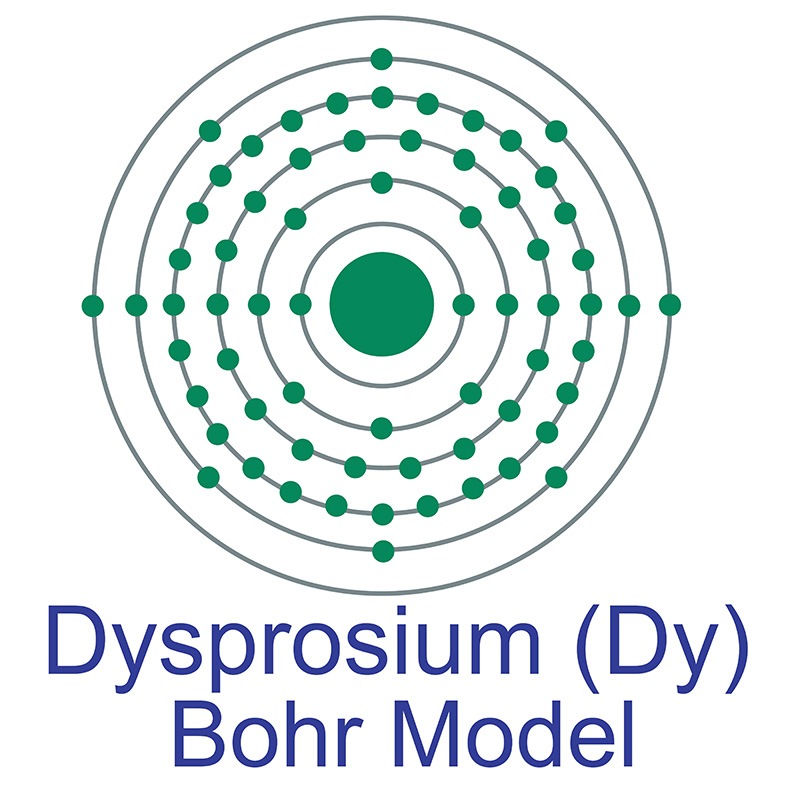 Dysprosium is most commonly used in neodymium-iron-boron high strength permanent magnets. While it has one of the highest magnetic moments of any of the rare earths (10.6µB), this has not resulted in an ability to perform on its own as a practical alternative to neodymium compositions. It is however now an essential additive in NdFeB production. It is also used in special ceramic compositions based on barium titanate (BaTiO) formulations. Recent research has examined the use of dysprosium in dysprosium-iron-garnet (DyIG) and silicon implanted with dysprosium and holmium to form donor centers. Dysprosium is added to various advanced optical formulations due to the fact that it emits in the 470-500 and 570-600 nm wavelengths. Dysprosium is available as metal and compounds with purities from 99% to 99.999% (ACS grade to ultra-high purity); metals in the form of foil, sputtering target, and rod, and compounds as submicron and nanopowder.
Dysprosium is most commonly used in neodymium-iron-boron high strength permanent magnets. While it has one of the highest magnetic moments of any of the rare earths (10.6µB), this has not resulted in an ability to perform on its own as a practical alternative to neodymium compositions. It is however now an essential additive in NdFeB production. It is also used in special ceramic compositions based on barium titanate (BaTiO) formulations. Recent research has examined the use of dysprosium in dysprosium-iron-garnet (DyIG) and silicon implanted with dysprosium and holmium to form donor centers. Dysprosium is added to various advanced optical formulations due to the fact that it emits in the 470-500 and 570-600 nm wavelengths. Dysprosium is available as metal and compounds with purities from 99% to 99.999% (ACS grade to ultra-high purity); metals in the form of foil, sputtering target, and rod, and compounds as submicron and nanopowder.
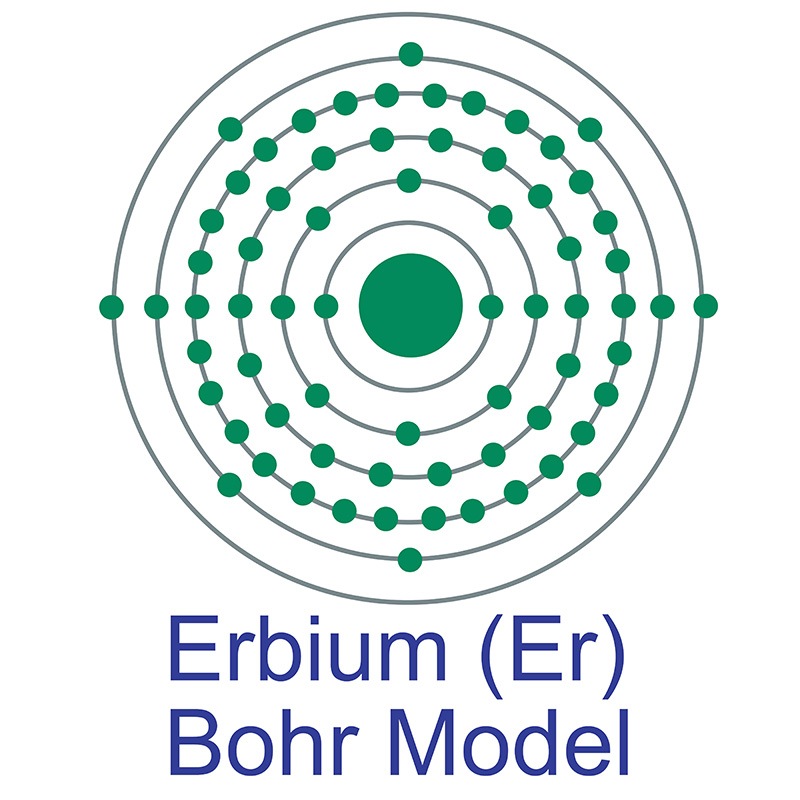 Erbium has application in glass coloring, as an amplifier in fiber optics, and in lasers for medical and dental use. The ion has a very narrow absorption band, coloring erbium salts pink; iIt is therefore used in eyeware and decorative glassware. It can neutralize discoloring impurities such as ferric ions and produce a neutral gray shade and s used in a variety of glass products for this purpose. It is particularly useful as an amplifier for fiber optic data transfer as it lases at the wavelength required to provide an efficient optical method of amplification, 1.55 microns. Lasers based on Er:YAG are ideally suited for surgical applications because of its ability to deliver energy without thermal build-up in tissue. Erbium is available as metal and compounds with purities from 99% to 99.999% (ACS grade to ultra-high purity); metals in the form of foil, sputtering target, and rod, and compounds as submicron and nanopowder.
Erbium has application in glass coloring, as an amplifier in fiber optics, and in lasers for medical and dental use. The ion has a very narrow absorption band, coloring erbium salts pink; iIt is therefore used in eyeware and decorative glassware. It can neutralize discoloring impurities such as ferric ions and produce a neutral gray shade and s used in a variety of glass products for this purpose. It is particularly useful as an amplifier for fiber optic data transfer as it lases at the wavelength required to provide an efficient optical method of amplification, 1.55 microns. Lasers based on Er:YAG are ideally suited for surgical applications because of its ability to deliver energy without thermal build-up in tissue. Erbium is available as metal and compounds with purities from 99% to 99.999% (ACS grade to ultra-high purity); metals in the form of foil, sputtering target, and rod, and compounds as submicron and nanopowder.
 Europium is utilized primarily for its unique luminescent behavior. Excitation of the europium atom by absorption of ultra violet radiation can result in specific energy level transitions within the atom, creating an emission of visible radiation .In energy efficient fluorescent lighting, europium oxide provides not only the necessary red but also the blue. Several commercial blue phosphors are based on europium. Its luminesence is also valuable in medical, surgical and biochemical applications. Europium is available as metal and compounds with purities from 99% to 99.999% (ACS grade to ultra-high purity); metals in the form of foil, sputtering target, and rod, and componds as submicron and nanopowder.
Europium is utilized primarily for its unique luminescent behavior. Excitation of the europium atom by absorption of ultra violet radiation can result in specific energy level transitions within the atom, creating an emission of visible radiation .In energy efficient fluorescent lighting, europium oxide provides not only the necessary red but also the blue. Several commercial blue phosphors are based on europium. Its luminesence is also valuable in medical, surgical and biochemical applications. Europium is available as metal and compounds with purities from 99% to 99.999% (ACS grade to ultra-high purity); metals in the form of foil, sputtering target, and rod, and componds as submicron and nanopowder.
 Gadolinium is utilized for both its high magnetic moment (7.94µB) and as a phosphor and scintillator material. When complexed with EDTA ligands, it is used as an injectable contrast agent for patients undergoing magnetic resonance imaging. With its high magnetic moment, gadolinium can reduce relaxation times and thereby enhance signal intensity. The extra stable half-full 4f electron shell with no low lying energy levels creates applications as an inert phosphor host. Gadolinium can therefore act as hosts for x-ray cassettes and in scintillator materials for computer tomography. Gadolinium is available as metal and compounds with purities from 99% to 99.999% (ACS grade to ultra-high purity); metals in the form of foil, sputtering target, and rod, and compounds as submicron and nanopowder.
Gadolinium is utilized for both its high magnetic moment (7.94µB) and as a phosphor and scintillator material. When complexed with EDTA ligands, it is used as an injectable contrast agent for patients undergoing magnetic resonance imaging. With its high magnetic moment, gadolinium can reduce relaxation times and thereby enhance signal intensity. The extra stable half-full 4f electron shell with no low lying energy levels creates applications as an inert phosphor host. Gadolinium can therefore act as hosts for x-ray cassettes and in scintillator materials for computer tomography. Gadolinium is available as metal and compounds with purities from 99% to 99.999% (ACS grade to ultra-high purity); metals in the form of foil, sputtering target, and rod, and compounds as submicron and nanopowder.
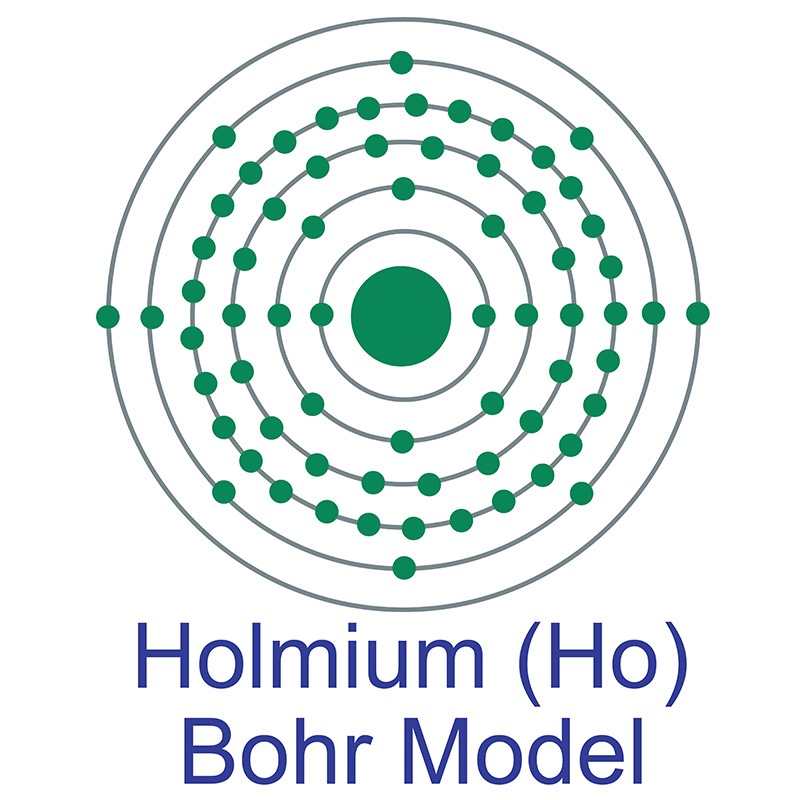 Holmium has the highest magnetic moment (10.6µB) of any naturally occurring element. Because of this it has been used to create the highest known magnetic fields by placing it within high strength magnets as a pole piece or magnetic flux concentrator. This magnetic property also has value in yttrium-iron-garnet (YIG) lasers for microwave equipment. Holmium lases at a human eye safe 2.08 microns ,allowing its use in a variety of medical and dental applications in both yttrium-aluminum-garnet (YAG) and yttrium-lithium-fluoride (YLF) solid state lasers. The wavelength allows for use in silica fibers designed for shorter wavelengths while still providing the cutting strength of longer wave length equipment. Holmium is available as metal and compounds with purities from 99% to 99.999% (ACS grade to ultra-high purity); metals in the form of foil, sputtering target, and rod, and compounds as submicron and nanopowder.
Holmium has the highest magnetic moment (10.6µB) of any naturally occurring element. Because of this it has been used to create the highest known magnetic fields by placing it within high strength magnets as a pole piece or magnetic flux concentrator. This magnetic property also has value in yttrium-iron-garnet (YIG) lasers for microwave equipment. Holmium lases at a human eye safe 2.08 microns ,allowing its use in a variety of medical and dental applications in both yttrium-aluminum-garnet (YAG) and yttrium-lithium-fluoride (YLF) solid state lasers. The wavelength allows for use in silica fibers designed for shorter wavelengths while still providing the cutting strength of longer wave length equipment. Holmium is available as metal and compounds with purities from 99% to 99.999% (ACS grade to ultra-high purity); metals in the form of foil, sputtering target, and rod, and compounds as submicron and nanopowder.
 Lanthanum is the first element in the rare earth or lanthanide series. It is the model for all the other trivalent rare earths. After cerium, it is the second most abundant of the rare earths. Lanthanum-rich lanthanide compositions have been used extensively for cracking reactions in FCC catalysts, especially to manufacture low-octane fuel for heavy crude oil. Lantahanum is found in monazite and bastnasite. The name Lanthanum originates from the Greek word Lanthaneia which means 'To lie hidden'. It is utilized in green phosphors based on the aluminate (La0.4Ce0.45Tb0.15)PO4. Lanthanide zirconates and lanthanum strontium manganites are used for their catalytic and conductivity properties and lanthanum stabilized zirconia has useful electrical and mechanical properties. Lanthanum's ability to bind with phosphates in water creates numerous uses in water treatment. It is utilized in laser crystals based on the yttrium-lanthanum-fluoride (YLF) composition. Lanthanum is available as metal and compounds with purities from 99% to 99.999% (ACS grade to ultra-high purity); metals in the form of foil, sputtering target, and rod, and compounds as submicron and nanopowder.
Lanthanum is the first element in the rare earth or lanthanide series. It is the model for all the other trivalent rare earths. After cerium, it is the second most abundant of the rare earths. Lanthanum-rich lanthanide compositions have been used extensively for cracking reactions in FCC catalysts, especially to manufacture low-octane fuel for heavy crude oil. Lantahanum is found in monazite and bastnasite. The name Lanthanum originates from the Greek word Lanthaneia which means 'To lie hidden'. It is utilized in green phosphors based on the aluminate (La0.4Ce0.45Tb0.15)PO4. Lanthanide zirconates and lanthanum strontium manganites are used for their catalytic and conductivity properties and lanthanum stabilized zirconia has useful electrical and mechanical properties. Lanthanum's ability to bind with phosphates in water creates numerous uses in water treatment. It is utilized in laser crystals based on the yttrium-lanthanum-fluoride (YLF) composition. Lanthanum is available as metal and compounds with purities from 99% to 99.999% (ACS grade to ultra-high purity); metals in the form of foil, sputtering target, and rod, and compounds as submicron and nanopowder.
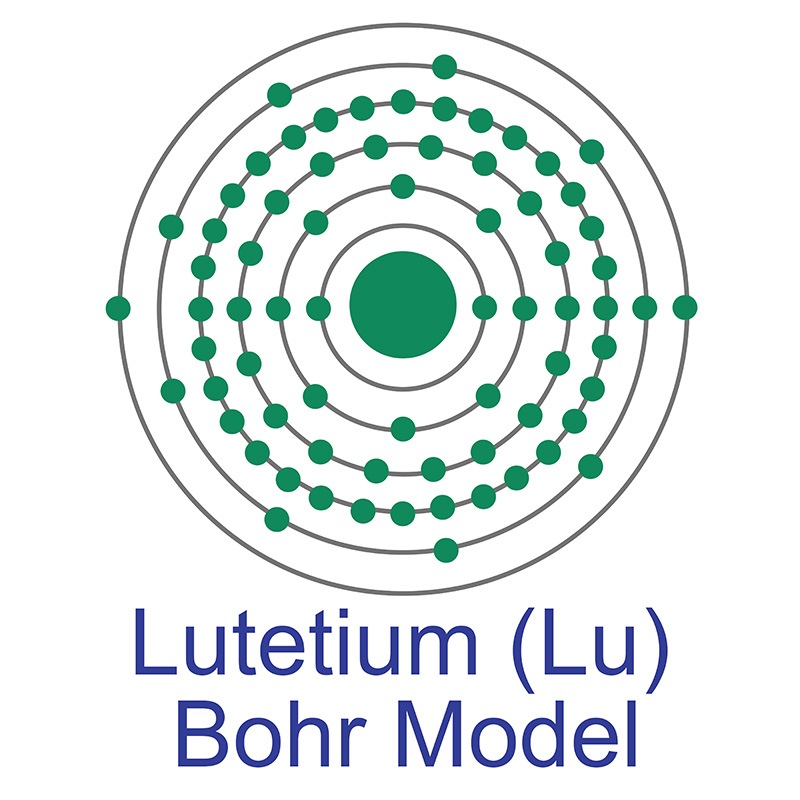 Lutetium is the last member of the rare earth series. Unlike most rare earths, it lacks a magnetic moment; it also has the smallest metallic radius of any rare earth. It is perhaps the least naturally abundant of the lanthanides. It is the ideal host for x-ray phosphors because it produces the densest known white material, lutetium tantalate (LuTaO4). It is utilized as a dopant in matching lattice parameters of certain substrate garnet crystals, such as indium-gallium-garnet (IGG) crystals due its lack of a magnetic moment. Lutetium is available as metal and compounds with purities from 99% to 99.999% (ACS grade to ultra-high purity); metals in the form of foil, sputtering target, and rod, and compounds as submicron and nanopowder.
Lutetium is the last member of the rare earth series. Unlike most rare earths, it lacks a magnetic moment; it also has the smallest metallic radius of any rare earth. It is perhaps the least naturally abundant of the lanthanides. It is the ideal host for x-ray phosphors because it produces the densest known white material, lutetium tantalate (LuTaO4). It is utilized as a dopant in matching lattice parameters of certain substrate garnet crystals, such as indium-gallium-garnet (IGG) crystals due its lack of a magnetic moment. Lutetium is available as metal and compounds with purities from 99% to 99.999% (ACS grade to ultra-high purity); metals in the form of foil, sputtering target, and rod, and compounds as submicron and nanopowder.
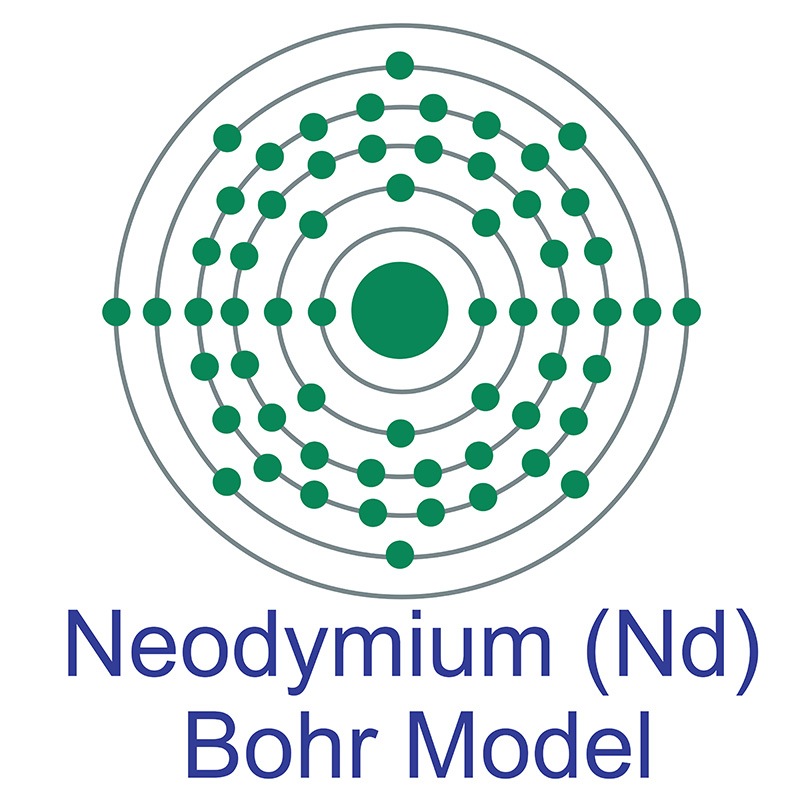 Neodymium is the most abundant of the rare earths after cerium and lanthanum. Primary applications include lasers, glass coloring and tinting, dielectrics and, most importantly, as the fundamental basis for neodymium-iron-boron permanent magnets. Neodymium has a strong absorption band centered at 580 nm, which is very close to the human eye's maximum level of sensitivity making it useful in protective lenses for welding goggles. It is also used in CRT displays to enhance contrast between reds and greens and highly valued in glass manufacturing for its attractive purple coloring. Neodymium is included in many formulations of barium titanate, used as dielectric coatings and in multi-layer capacitors essential to electronic equipment. Neodymium is available as metal and compounds with purities from 99% to 99.999% (ACS grade to ultra-high purity); metals in the form of foil, sputtering target, and rod, and compounds as submicron and nanopowder.
Neodymium is the most abundant of the rare earths after cerium and lanthanum. Primary applications include lasers, glass coloring and tinting, dielectrics and, most importantly, as the fundamental basis for neodymium-iron-boron permanent magnets. Neodymium has a strong absorption band centered at 580 nm, which is very close to the human eye's maximum level of sensitivity making it useful in protective lenses for welding goggles. It is also used in CRT displays to enhance contrast between reds and greens and highly valued in glass manufacturing for its attractive purple coloring. Neodymium is included in many formulations of barium titanate, used as dielectric coatings and in multi-layer capacitors essential to electronic equipment. Neodymium is available as metal and compounds with purities from 99% to 99.999% (ACS grade to ultra-high purity); metals in the form of foil, sputtering target, and rod, and compounds as submicron and nanopowder.
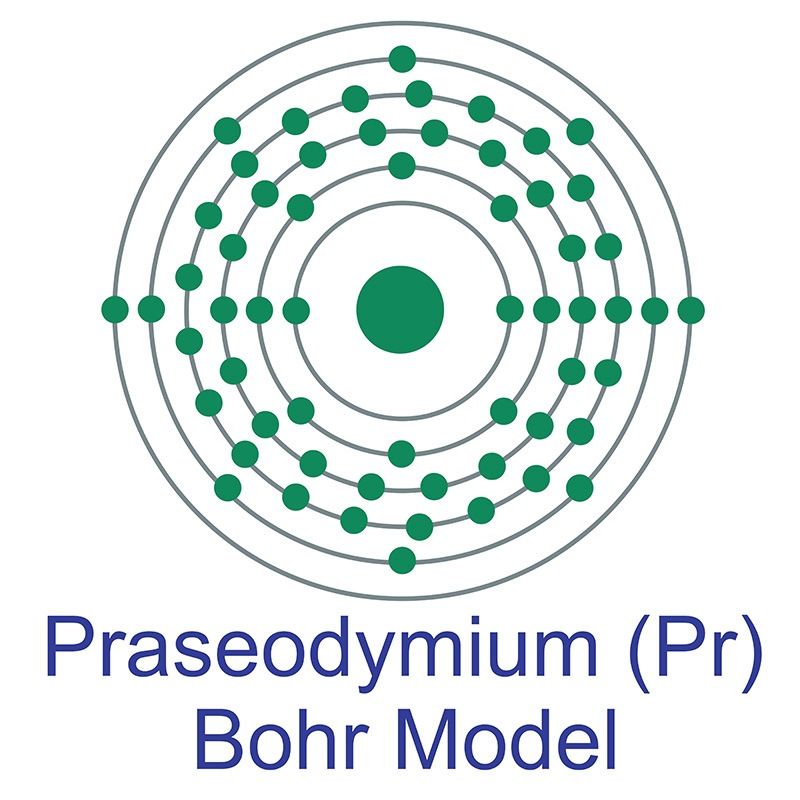 Praseodymium resembles the typical trivalent rare earths; however, it will exhibit a +4 state when stabilized in a zirconia host. The element is found in most all light rare earth derivatives. It is highly valued in glass and ceramic production as a bright yellow pigment because of its optimum reflectance at 560 nm. Much research is being done on its optical properties for use in amplification of telecommunication systems, including as a doping agent in fluoride fibers. Praseodymium doped zirconia is a potential cathode for low temperature solid oxide fuel cell (SOFC) applications. It is also used in the scintillator for medical CAT scans. Praseodymium is available as metal and compounds with purities from 99% to 99.999% (ACS grade to ultra-high purity); metals in the form of foil, sputtering target, and rod, and compounds as submicron and nanopowder.
Praseodymium resembles the typical trivalent rare earths; however, it will exhibit a +4 state when stabilized in a zirconia host. The element is found in most all light rare earth derivatives. It is highly valued in glass and ceramic production as a bright yellow pigment because of its optimum reflectance at 560 nm. Much research is being done on its optical properties for use in amplification of telecommunication systems, including as a doping agent in fluoride fibers. Praseodymium doped zirconia is a potential cathode for low temperature solid oxide fuel cell (SOFC) applications. It is also used in the scintillator for medical CAT scans. Praseodymium is available as metal and compounds with purities from 99% to 99.999% (ACS grade to ultra-high purity); metals in the form of foil, sputtering target, and rod, and compounds as submicron and nanopowder.
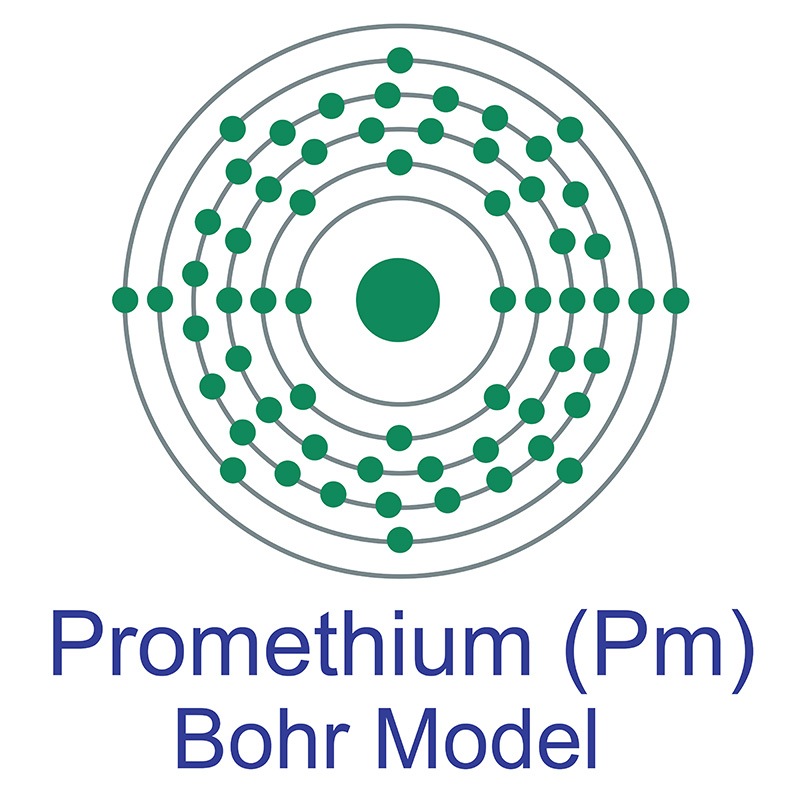 Promethium is the only radioactive member of the rare earths, and the last to be discovered. The existence of an unknown element with atomic number 61 was predicted in 1914 by Henry Mosley, but the metal was not successfully produced and fully characterized until 1945 by Jacob A. Marinsky, Lawrence E. Glendenin, and Charles D. Coryell at the Oak Ridge National Laboratory. The name was derived from, Prometheus the Titan in Greek mythology who stole fire from Mount Olympus to give to humans. All of promethium’s isotopes are radioactive and have short half-lives, so appreciable amounts are not found in natural sources. Since the element can only be obtained from a lab, it has few applications. The only isotope of promethium used outside of research is promethium-147, which is produced and used in very small (milligram) quantities in atomic batteries and signal lights containing phosphors that emit light in response to absorption of radiation emitted by the isotope. Since this relatively stable isotope emits x-rays, it could theoretically be used for portable x-ray sources.
Promethium is the only radioactive member of the rare earths, and the last to be discovered. The existence of an unknown element with atomic number 61 was predicted in 1914 by Henry Mosley, but the metal was not successfully produced and fully characterized until 1945 by Jacob A. Marinsky, Lawrence E. Glendenin, and Charles D. Coryell at the Oak Ridge National Laboratory. The name was derived from, Prometheus the Titan in Greek mythology who stole fire from Mount Olympus to give to humans. All of promethium’s isotopes are radioactive and have short half-lives, so appreciable amounts are not found in natural sources. Since the element can only be obtained from a lab, it has few applications. The only isotope of promethium used outside of research is promethium-147, which is produced and used in very small (milligram) quantities in atomic batteries and signal lights containing phosphors that emit light in response to absorption of radiation emitted by the isotope. Since this relatively stable isotope emits x-rays, it could theoretically be used for portable x-ray sources.
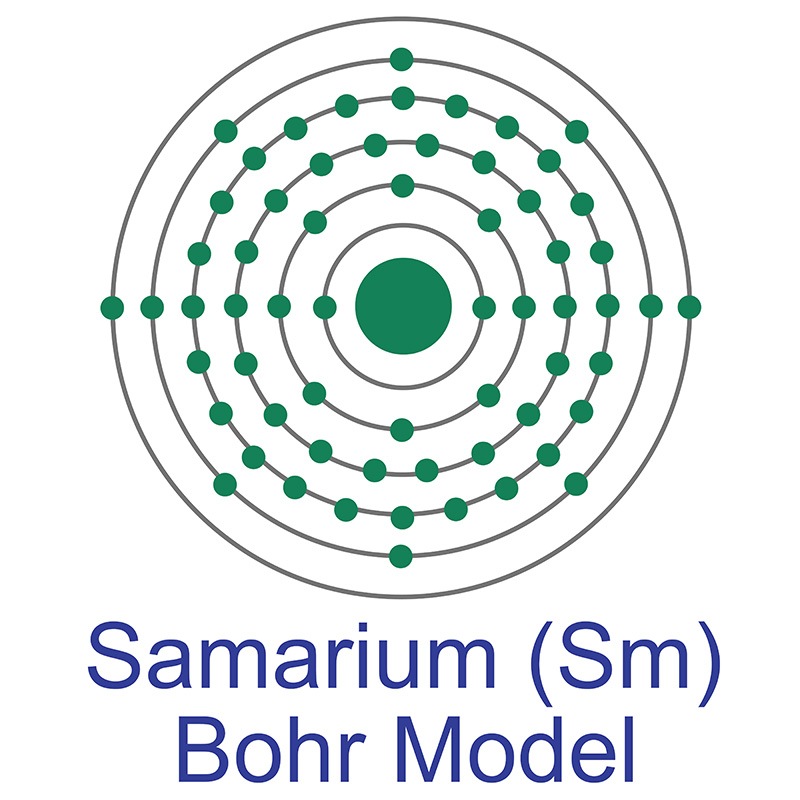 Samarium is primarily utilized in the production of samarium-cobalt (Sm2Co17) permanent magnets, which replaced the more expensive platinum-cobalt magnets in the early 1970s. While now overshadowed by the less expensive neodymium-iron-boron magnets, they are still valued for their ability to function at high temperatures. They are utilized in lightweight electronic equipment where size or space is a limiting factor and where functionality at high temperature is a concern. Applications include electronic watches, aeospace equipment, microwave technology and servomotors. Because of its weak spectral absorption band samarium is used in the filter glass on Nd:YAG solid state lasers to surround the laser rod to improve efficiency by absorbing stray emissions. Samarium forms stable titanate compounds with useful dielectric properties suitable for coatings and in capacitors at microwave frequencies. It is also used in laser applications, and for its dielectric properties. Samarium is available as metal and compounds with purities from 99% to 99.999% (ACS grade to ultra-high purity); metals in the form of foil, sputtering target, and rod, and compounds as submicron and nanopowder.
Samarium is primarily utilized in the production of samarium-cobalt (Sm2Co17) permanent magnets, which replaced the more expensive platinum-cobalt magnets in the early 1970s. While now overshadowed by the less expensive neodymium-iron-boron magnets, they are still valued for their ability to function at high temperatures. They are utilized in lightweight electronic equipment where size or space is a limiting factor and where functionality at high temperature is a concern. Applications include electronic watches, aeospace equipment, microwave technology and servomotors. Because of its weak spectral absorption band samarium is used in the filter glass on Nd:YAG solid state lasers to surround the laser rod to improve efficiency by absorbing stray emissions. Samarium forms stable titanate compounds with useful dielectric properties suitable for coatings and in capacitors at microwave frequencies. It is also used in laser applications, and for its dielectric properties. Samarium is available as metal and compounds with purities from 99% to 99.999% (ACS grade to ultra-high purity); metals in the form of foil, sputtering target, and rod, and compounds as submicron and nanopowder.
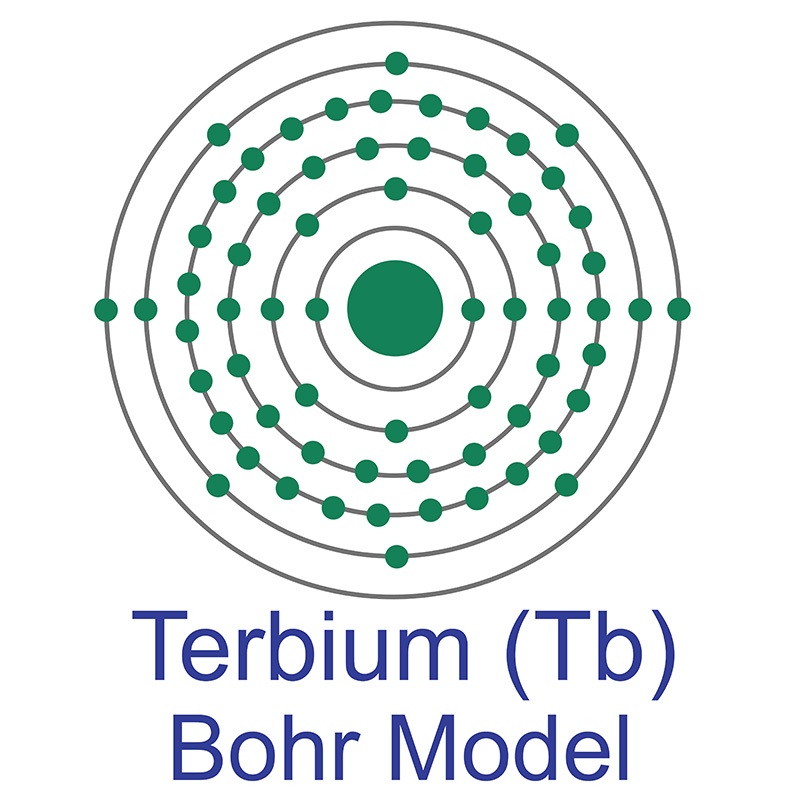 Terbium is primarily used in phosphors, particularly in fluorescent lamps and as the high intensity green emitter used in projection televisions, such as the yttrium-aluminum-garnet (Tb:YAG) variety. Terbium responds efficiently in x-ray excitation and is, therefore, used as an x-ray phosphor. Terbium alloys are also used in magneto-optic recording films, such as Tb-Fe-Co. A variety of terbium-doped compounds can act as phosphors for use in television screens, other displays, lighting, or sensors. Most notably, terbium green phosphors are used in trichromatic fluorescent lamps along with europium blue and red phosphors to produce white light with greater energy efficiency than incandescent lighting. In zirconia oxide ceramics, terbium can act both as a light-emitting dopant and a crystal stabilizer, producing a material with excellent structural and optical properties. Other terbium doped compounds have useful electrical properties that make them potentially useful in the semiconductor industry. Terfenol-D is an alloy of terbium, iron, and dysprosium that is magnetostrictive: it contracts or expands when exposed to magnetic fields. This property allows direct conversion between electrical and mechanical power, and the alloy is used in sensors, actuators, and acoustic and ultrasonic transducers, and active noise and vibration cancelling devices. Terbium is available as metal and compounds with purities from 99% to 99.999% (ACS grade to ultra-high purity); metals in the form of foil, sputtering target, and rod, and componds as submicron and nanopowder.
Terbium is primarily used in phosphors, particularly in fluorescent lamps and as the high intensity green emitter used in projection televisions, such as the yttrium-aluminum-garnet (Tb:YAG) variety. Terbium responds efficiently in x-ray excitation and is, therefore, used as an x-ray phosphor. Terbium alloys are also used in magneto-optic recording films, such as Tb-Fe-Co. A variety of terbium-doped compounds can act as phosphors for use in television screens, other displays, lighting, or sensors. Most notably, terbium green phosphors are used in trichromatic fluorescent lamps along with europium blue and red phosphors to produce white light with greater energy efficiency than incandescent lighting. In zirconia oxide ceramics, terbium can act both as a light-emitting dopant and a crystal stabilizer, producing a material with excellent structural and optical properties. Other terbium doped compounds have useful electrical properties that make them potentially useful in the semiconductor industry. Terfenol-D is an alloy of terbium, iron, and dysprosium that is magnetostrictive: it contracts or expands when exposed to magnetic fields. This property allows direct conversion between electrical and mechanical power, and the alloy is used in sensors, actuators, and acoustic and ultrasonic transducers, and active noise and vibration cancelling devices. Terbium is available as metal and compounds with purities from 99% to 99.999% (ACS grade to ultra-high purity); metals in the form of foil, sputtering target, and rod, and componds as submicron and nanopowder.
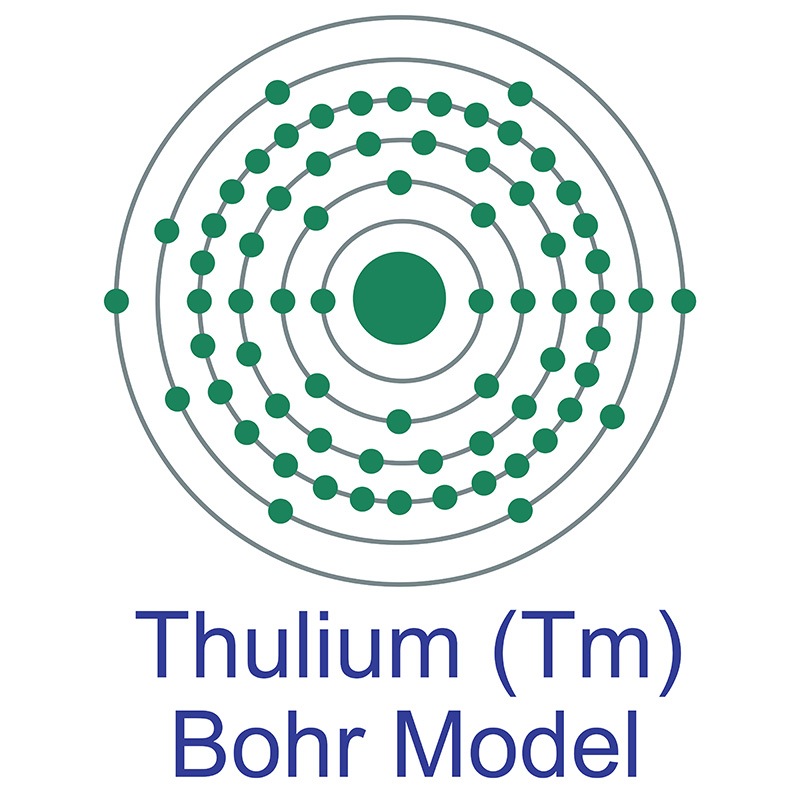 Thulium is representative of the other lanthanides (rare earths), similar in chemistry to yttrium. Notably, it is used as a dopant for garnets used as laser gain media, and such lasers are used in medical laser applications such as laser surgery as well as in industrial and military applications. The radioactive isotope thulium-170 can be produced in nuclear reactors and is found in portable x-ray devices used for medical diagnostics and manufacturing quality-control applications. Additionally, this isotope can be used for radiotherapy cancer treatment. Thulium may be also used in high-temperature superconductors, magnetic ceramic materials, personal radiation dosimeters, and phosphors for use in anti-counterfeiting features of modern currency notes such as the Euro. Thulium is available as metal and compounds with purities from 99% to 99.999% (ACS grade to ultra-high purity); metals in the form of foil, sputtering target, and rod, and componds as submicron and nanopowder.
Thulium is representative of the other lanthanides (rare earths), similar in chemistry to yttrium. Notably, it is used as a dopant for garnets used as laser gain media, and such lasers are used in medical laser applications such as laser surgery as well as in industrial and military applications. The radioactive isotope thulium-170 can be produced in nuclear reactors and is found in portable x-ray devices used for medical diagnostics and manufacturing quality-control applications. Additionally, this isotope can be used for radiotherapy cancer treatment. Thulium may be also used in high-temperature superconductors, magnetic ceramic materials, personal radiation dosimeters, and phosphors for use in anti-counterfeiting features of modern currency notes such as the Euro. Thulium is available as metal and compounds with purities from 99% to 99.999% (ACS grade to ultra-high purity); metals in the form of foil, sputtering target, and rod, and componds as submicron and nanopowder.
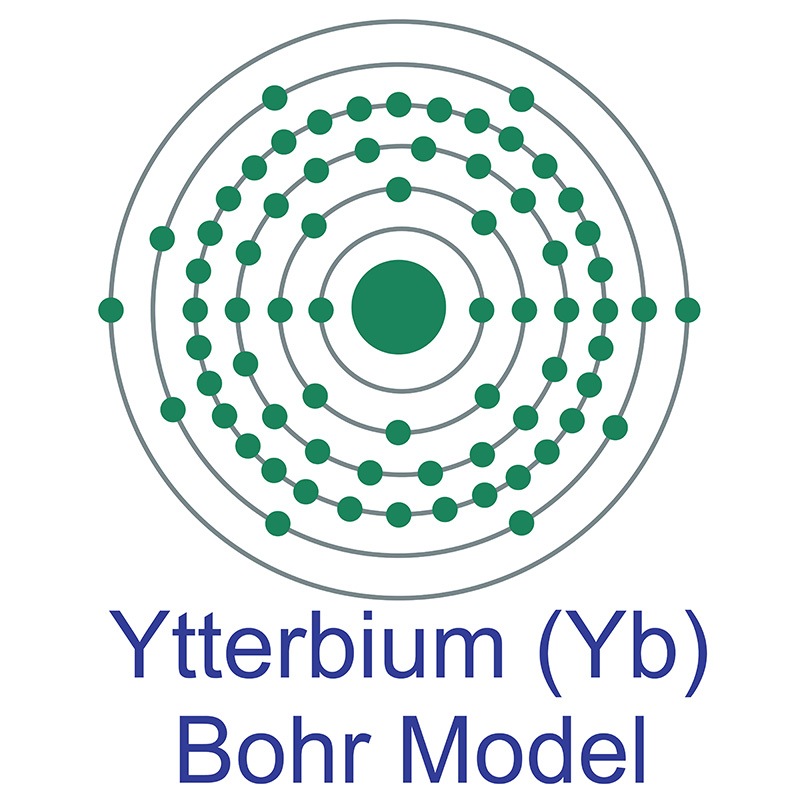 Ytterbium is being applied to numerous fiber amplifier and fiber optic technologies and in various lasing applications. It has a single dominant absorption band at 985 in the infrared range, making it useful in silicon photocells to directly convert radiant energy to electricity. Ytterbium metal increases its electrical resistance when subjected to very high stresses. This property is used in stress gauges for monitoring ground deformations from earthquakes and nuclear explosions. It is also used in thermal barrier system bond coatings on nickel, iron, and other transitional metal alloy substrates. Ytterbium is available as metal and compounds with purities from 99% to 99.999% (ACS grade to ultra-high purity); metals in the form of foil, sputtering target, and rod, and componds as submicron and nanopowder.
Ytterbium is being applied to numerous fiber amplifier and fiber optic technologies and in various lasing applications. It has a single dominant absorption band at 985 in the infrared range, making it useful in silicon photocells to directly convert radiant energy to electricity. Ytterbium metal increases its electrical resistance when subjected to very high stresses. This property is used in stress gauges for monitoring ground deformations from earthquakes and nuclear explosions. It is also used in thermal barrier system bond coatings on nickel, iron, and other transitional metal alloy substrates. Ytterbium is available as metal and compounds with purities from 99% to 99.999% (ACS grade to ultra-high purity); metals in the form of foil, sputtering target, and rod, and componds as submicron and nanopowder.